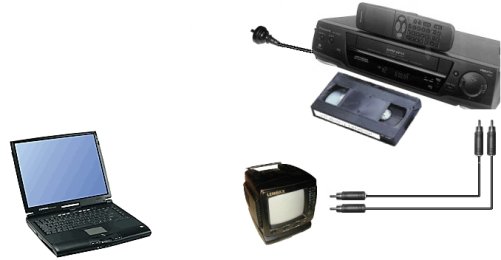




Welcome to Murray Logan's Koala Research Page
A 25 ha study site was located in coastal manna gum woodland on the SW side of Raymond Island, approximately 300 km east of Melbourne (see Figure below), Australia (38° 55', 147° 45'). The low, open vegetation was dominated by coastal manna gum (Eucalyptus viminalis pryoriana) with a thick understory of bracken fern (Pteridium esculentum), the former representing a dietary monoculture with respect to known koala food tree species (see Figure below). Banksia serrata, B. integrifolia, Acacia longifolia and Exocarpus cupressiformis were also present, and although rarely consumed, they provide more shade than manna gums and were frequently used on hot days.
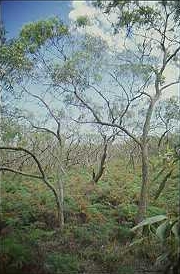

The study site was bounded to the north and west by the Raymond Island residential township and to the south and east by Lake Victoria. The study area was extensively dissected by tracks and paths, most of which were regularly traversed by locals and tourists. Consequently, the koalas were well habituated to humans and generally appear undisturbed on approach. The tracks also enabled monitoring equipment to be nominally positioned and if necessary repositioned, relatively close to any koala within the study area. A detailed map of the study area with a 50x50 m gridded overlay that included tracks, paths and prominent vegetative features was constructed for the purpose of recording animal locations.
A red shredded flag, attached to the end of an extendible aluminium pole and waved vigorously above the head of a koala as well as beyond and along the branch occupied by the koala, was used to initially maneuver koalas down branches and onto the main trunk. The lightness and extendibility of the pole enabled the flag to be positioned at a wide range of heights and from a range of approach angles. Maneuvering was controlled and managed so as to maintain a balance between swift capture (to minimize the amount of stress endured by the animal) and a complete panic in which the risks of injury or stress become unacceptably high.
Once the koala was maneuvered onto the main truck, a second, aluminium, expendable pole was used to position a tether around the neck of the koala. Continual tension was exerted on the tether while continually waving the flag so as to prevent the koala from ascending the tree in an attempt to avoid the flag and catcher. Upon the koala reaching the ground, the tether was used as a leash to prevent escape and the animal was placed into a large, hessian potatoe sack.
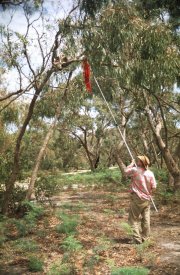

All captured koalas were weighed, assessed, tagged (with a small colored ear tag for identification) and released within 10 minutes of cature and into the reee from which it had been captured. Assessment included general general body condition, degree of tooth wear and reproductive status.
Tooth wear gradually alters the topography of the teeth. The teeth of koalas start off with sharp cusps and ridges (left photo below), however the abrasive properties of the diet wear these shearing edges down until, in a stage of advanced wear, the teeth are polished flat, scalloped or even missing (right photo below). At this point, the teeth are ineffective and the animal dies of starvation with a gut full of under-processed food material.
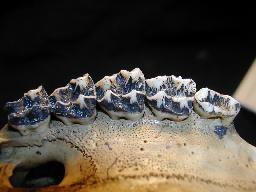
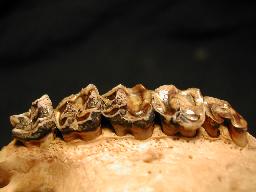
Six male koalas varying in degree of tooth wear from unworn to very worn were fitted with wildlife collars containing newly developed acoustically sensitive transmitters (Sirtrack). Three lactating female koalas and three non-lactating adult female koalas were also collared. These transmitters (pictured below), have a tiny microphone (similar to that of a mobile phones) and are capable of detecting and transmitting sounds (those made by the animal as well as ambient sounds) up to 1000 meters. By listening in to these sounds, it is possible to remotely monitor animal behaviour with minimal disturbance and influence on the animals.
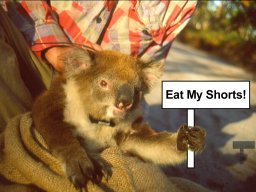

Microphone transmissions were continuously recorded onto three sequential, 5 hour stereo HiFi BASF PHG300 video cassette tapes, using a long play, Panasonic stereo HiFi NV-HD620 VCR (Japan) via a Uniden Bearcat (66-512 MHz, 1k) scanner attached to an in-line signal preamplifier and Discone wide band, omni-directional antenna raised to 5 m. The VCR and scanner were powered by one of three Century 86T deep-cycle batteries in a charge-discharge rotational cycle, via a 140-W Jaycar power inverter. A concurrent video time stamp was provided by an IR CCD camera focused on a small stopwatch that was illuminated by two infrared lights. The preamplifier, camera and infrared lights were powered by separate 7 AH Panasonic gell cells and a capacitative power source was used for the VCR and scanner to reduce cross electrical interference between appliances. A diagrammatic representation of the telemetry system appears in the diagram below.
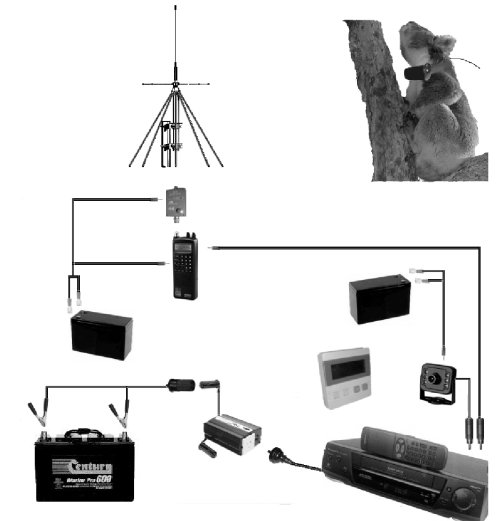
Over 570 hours of VCR tapes were played back in real time through an AV monitor that was capable of displaying the video time signal and amplifying the audio signal. Amplification was necessary to compensate for recording signals quietened by an impedance imbalance between the scanner receiver output and the VCR input. Software that I developed specifically for transcribing animal activities, synchronized to the VCR playback, permitted each audibly recognizable event (such as an ingestive mastication) to be digitally flagged, along with the exact time and date at which the event or activity had occurred. Event and activity transcription is represented diagrammatically in the figure below.
